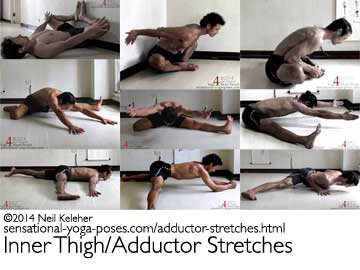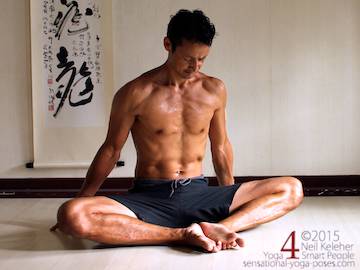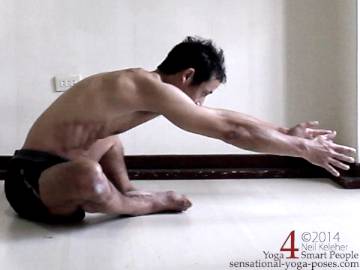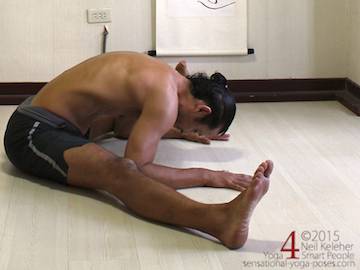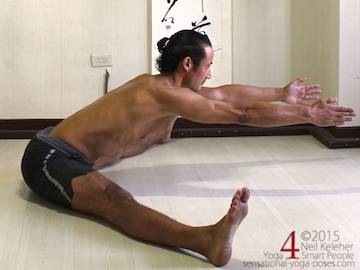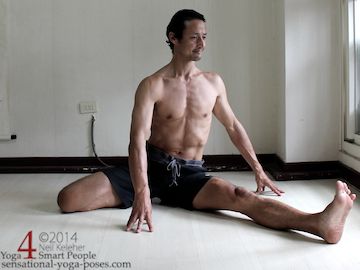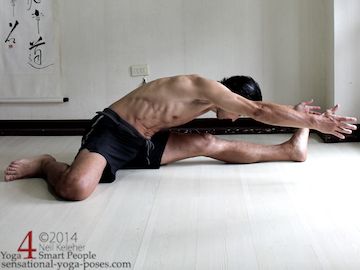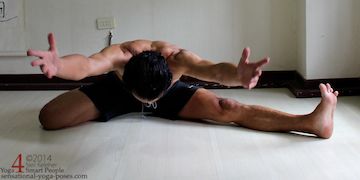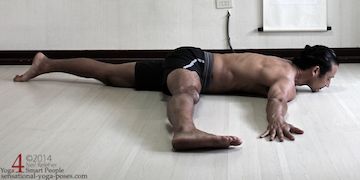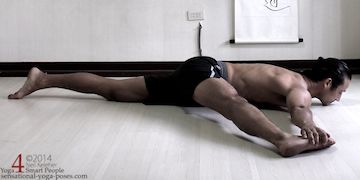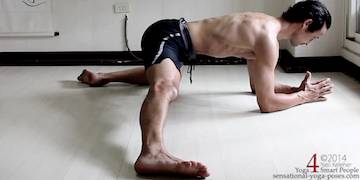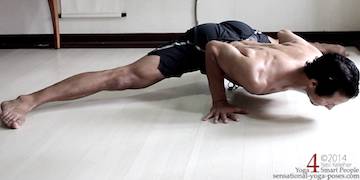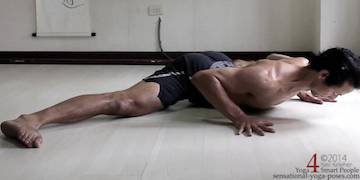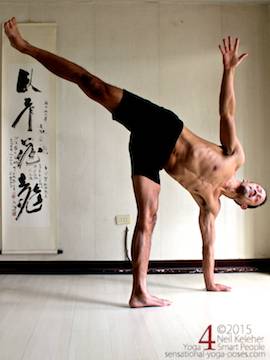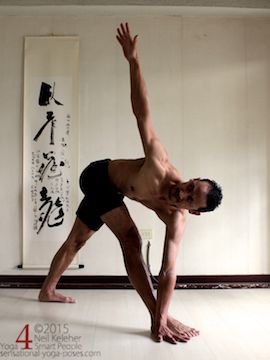Adductor Stretches
Stretches for Improving Inner Thigh Flexibility and Control
Adductor stretches (or stretches for the inner thighs) include both bent knee and straight knee positions. If you have very tight inner thighs you may find it helpful to use a wall to stretch them while laying supine.
You may also find a wall helpful as a prop while sitting upright.
For a basic understanding of the adductors and inner thighs read Adductors and inner thigh muscles.
Adductor Stretches Index
Click section headings to return to this index.
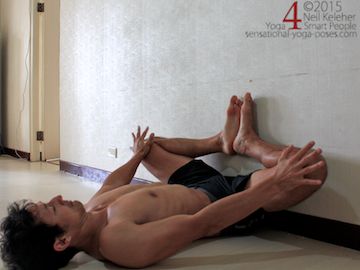
Wall stretch: bound angle
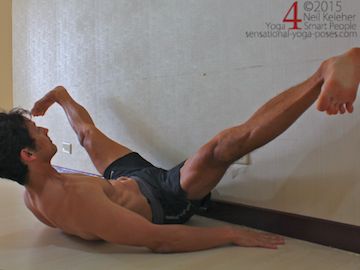
Wall stretch: Wide leg stretch
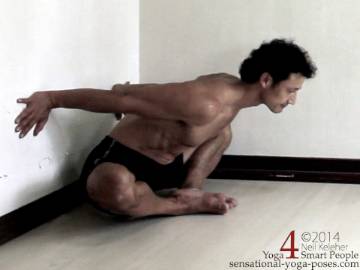
Bound angle w/ back to wall
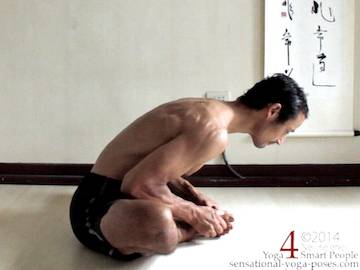
Bound angle grabbing feet
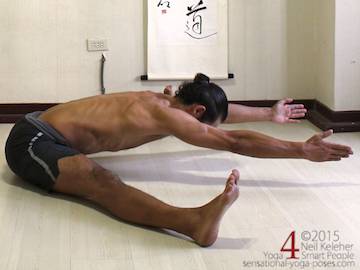
Wide leg front fold
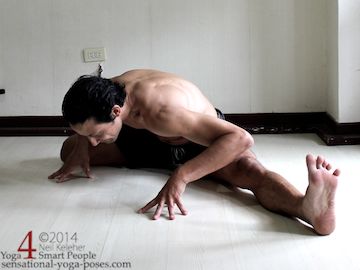
Hurdlers stretch adductor variant

Prone big toe pose
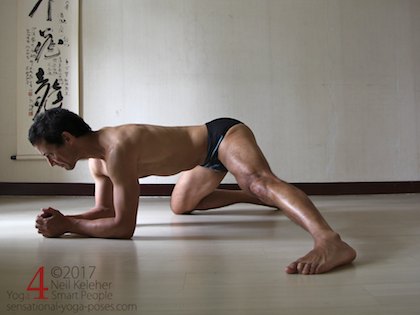
Half side split
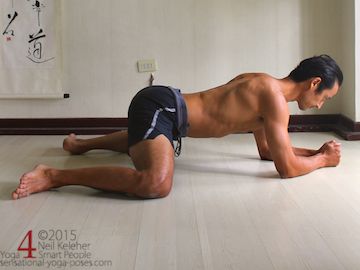
Frog pose adductor stretch
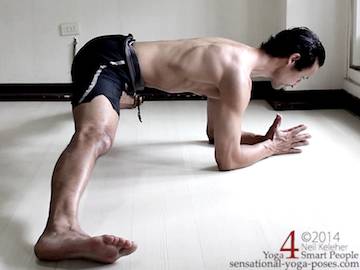
Side-to-side splits
Two supine wall assisted adductor stretches are bound angle and wide angle. For both stretches lay on your back with your butt against a wall and your feet up the wall.
For the bound angle adductor stretch, bend the knees and bring the soles of the feet together. Keep the edges of your feet against the wall and you can then use your hands to help press your knees towards the wall. Another option is to press your feet into the wall and use the action of your glutes and outer thighs to press your knees towards the wall.
For the wide angle adductor stretch, straighten the knees and move the legs out to the side. You can experiment with alternately pressing the feet into the wall and then pulling them away from the wall. Another option is to gently squeeze and release the inner thighs.
The same two poses can be done while sitting upright with your back against a wall. In this case press your hands against the wall to help create a forward bend. For bound angle this will help you to stretch the adductors. In wide leg forward bend (not shown) it will stretch the hamstrings more than the adductors.
Seated adductor stretches include bound angle, wide leg forward bend, and hurdlers stretch.
For bound angle pose, start seated with knees bent and feet together with feet close to your pubic bone. Spread the inner edges of the feet so that your knees can sink down to the ground easier. Then press the outer edges of the feet into the floor.
You can have your hands on the floor behind you to start with. Press your hands down into the floor using your shoulders to lift your chest. It can feel like you are trying to lift your butt using your hands and feet.
As you press down with your feet notice the tension created along the outer thigh and shin. It's this tension that will help pull your knees down to the floor.
Next bend forwards. Continue to press the outer edges of your feet into the floor. If you can bend forwards without using the wall, reach your hands forwards along the floor. To add weight to the stretch lift your hands off of the floor. Reach your arms forwards to add more weight.
To use muscle power to assist the adductor stretch, grab your feet with both hands. Continue to press your feet down and pull up with your arms at the same time so that your ribcage moves towards your feet. You can bend your spine forwards (engage your abs) or keep it straight (engage your spinal erectors.)
For more on this pose, including foot actions and optional foot positioning, read Bound angle pose.
One action you can focus on while doing this pose is opening the hip creases. Read more about that in Opening the hip creases in bound angle pose.
Wide leg forward bend can be used as an adductor stretch if you have the legs open wider than 90 degrees.
Start with your hands or elbows on the floor (legs wide and knees straight.) Press the legs down, lift your hands and reach them forwards. Lower and repeat. You may find that you sink gradually deeper each time. The wider your legs are the harder it will be to lift the hands.
Another option that is to place the hands against the inside of the shins while bent forwards. Press the hands against the shins and resist with the inner thighs as it trying to squeeze the legs together.
You may find that while using the hands against the legs you sink deeper into the forward bend and you also widen the legs at the same time.
To increase the stretch move the hands higher up the inner shins (closer to the knees or pelvis). As the legs get wider this option becomes a little bit more challenging.
Another option is to work at using the outer hip and thigh muscles to widen the legs while bent forwards. The hands or elbows or even the chin can be on the floor. I'd suggest lengthening the spine and widening the legs while inhaling and then relaxing both actions while exhaling.
For more on this pose you can read wide leg forward bend and upavishta konasana.
For more on how to widen the legs in this position (and so stretch your adductors) read seated straddle stretch..
Hurdlers stretch can be done in two ways. The first stretches the hamstring of the straight leg while the second focuses more on the adductor of the bent knee leg.
Sit with one leg straight the other knee bent with thighs open 90 degrees. Have the shin of the bent leg folded to the outside of the thigh with the inner edge of the foot on the floor. If this position hurts the knee then sit with the top of the foot on the floor and work towards having the inner edge of the foot on the floor.
Face the straight leg and bend forwards using the hands to support the weight of the upper body. Then gradually relax the arms, lift the hands and reach the arms forwards. Next, sit up and turn 45 degrees towards the bent knee so that you face the angle between the legs. Here again bend forwards using the hands to support the weight of your upper body.
This second position is the one that stretches the adductors of the bent knee leg. As you hold this position work at keeping your spine long. Move the hip crest of the bent leg forwards or backwards to see if that makes the position more comfortable. Breath deeply!
You can do then relax the arms, slowly lift them and reach them forwards.
Hold for a few breaths and then slowly sit up. For bonus points, sit up from both positions while continuing to reach with your arms.
If you find this position to uncomfortable, try it while sitting with your butt on a pair of yoga blocks.
For more on hurdler's stretch, including tips for how to keep the knee of your bent knee leg safe, read hurdlers stretch.
Prone adductor stretches include prone big toe pose, frog pose (another variation), half side split and full side splits.
A relaxing adductor stretch is prone big toe pose.
From a laying on your belly position lift one hip, sweep the leg out the side with the knee pointing forwards. Place the inner edge of the foot on the floor. You can grab the foot with the hand if possible.
Press the hip down.
From here a slightly more intense adductor stretch is half split or half side splits.
Kneel with one knee on the floor and the other leg to the side.
This position is exactly like doing side to side splits except that one knee is bent. Place both hands on the floor with elbows straight.
Gradually slide the foot of the straight leg away from the bent knee. (When using a mat I place the bent knee on the mat and the straight leg foot on the surface of the floor so that it slides easier.)
As you go lower place your elbows on the floor.
I'd suggest activating the outer thighs of both legs to help you work deeper. You can also focus on relaxing the inner thighs.
If you can get low enough, put your hands on the floor bend the elbows and (reaching forwards if you have to) place your chest on the floor. Rest for a moment or two and then use your arms to lift your chest an inch off of the floor. Hold for a few breaths or more then put your chest on the floor and relax.
Each time you lift your chest engage your inner thighs. When you put it on the floor again relax them.
Rest in a kneeling position in between sides.
If I have mixed level students an option for beginners instead of full side splits is frog pose. There are several types of "frog pose" one of which is a quadriceps stretch. As an adductor stretch frog pose is like side splits but with both knees bent. The trick in this pose is sliding the knees apart to stretch the inner thighs. Depending on the surface you are on you may find it helpful to wiggle your finger tips beneath your knees, so that your knees can slightly outwards gradually further.
Play with the position of your pelvis relative to your knees. Try this bent knee adductor stretch with hips forwards, with hips in line with the knees and then with the hips behind the knees.
You can also play with the tilt of your pelvis, tilting the pelvis forwards in such a way that the lumbar lordosis is increased or tilting the pelvis backwards so that the lower back is flatter. In each case notice the sensations emanating from the hip joint. Which position makes the hip joint most comfortable?
(In general I tend to find that tilting the pelvis forwards makes my hip joints more comfortable. A more advance practice can involve figuring out how to configure the body with pelvis tilted backwards so that the hip joints are comfortable in this type of position.)
From half side splits the logical progression is side-to-side splits (also called middle splits or box splits). In any practice session you could start by using half splits first as a warm up for side to side splits. Over the course of time you can ditch the half splits and work on side to side splits without the preparation.
This is a challenging adductor stretch because the muscles being stretched, the adductors, are also trying to support the body. And so it helps if you can use your arms to provide some stability. Start with hands on the floor and elbows straight. As you go deeper you can place your elbows on the floor.
As you go deeper yet, place hands on the floor, bend the elbows and lower the chest towards the floor as if lowering down from a push up. Anytime you need to rest place your chest on the floor. In this position focus on relaxing the inner thighs. Let the pelvis sink down as you relax the inner thighs. Try to let the pelvis feel heavy. That's a good indication that you are relaxing the inner thighs more or less completely.
Normal tendency is to move forwards to get the hips down. Work at pushing the hips rearwards so that viewed from the side your hips are either in line with the feet or behind the feet.
If resting your chest on the floor, you can add weight to the stretch by using your arms to lift your chest an inch off of the floor, engaging inner thighs at same time. Then lower your chest to the floor and relax the inner thighs. With the chest lifted, play with activating the outer thighs to give the stretch a muscular assist. Try to use the outer thighs to widen your legs.
Middle Splits, Minding Your Knees
If you find progress in your side-to-side or "middle" splits reaches a plateau you might find it helpful to focus on Knee Joint Integrity while doing middle splits.
Additionally, you can read about Stabilizing the knee joint in middle splits.
Why should I stabilize my knees when doing middle splits?
One reason for stabilizing the knees in middle splits is that a set of muscles, which could be called "the long hip muscles" extend from the lower leg, just below the knee to the corner points of the hip bone. These muscles act on both the inner aspect of the thigh and the outer aspect of the thigh.
By stabilizing the knee joint you give these muscles a stable foundation from which to activate (or relax). More importantly, or just as importantly, it signals to the brain that the knee joints (and the hip joints) are both safe, because muscles that act on both are operational.
Why is this important? It means that the joint capsules can be tensioned (by muscle activation) which in turn means that joint fluid is pressurized which allows the bones of the joint to adjust relative to each other which in turn means that tension within the joint capsule and related connective tissue structures is evenly distributed.
It basically signals to your brain that your joints are safe.
Hip Reactivation Poses
After side to side splits your legs, particularly your hips may feel weak or floppy. For that reason follow splits or half splits with hip reactivation poses. You may find standing side bend helpful, or half moon or revolved (twisted) triangle.
To make these poses extra effective for reactivating the hips you can try deliberately activating either your hips (try "squeezing" your hip joints) or deliberately activating adductors and abductors.
Related
For a better understanding of the adductors (and inner thigh muscles in general) read Adductors and inner thigh muscles.
More Hip Stretches
Published: 2020 09 18
